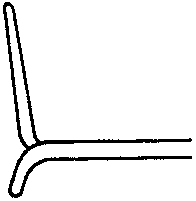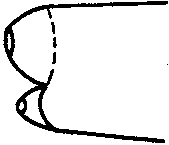
|
|
1894 Frederick William LANCHESTER (UK) 1909 Georges BARBAUDY (France) 1934 Arthur W. Loerke (USA) 1943 Pierre Marcel LEMOIGNE (France) 1969 William R. Haney.Jr (USA) 1973 Martin LESSEN (USA) 1981 Ver Flugtechnische Werke (DEUTSCHLAND) 1985 Richard T. WHICOMB (USA) 1992 Louis B. GRATZER (USA) 1995 Ulrich LA ROCHE (SUISSE) |
|||||||
| We have seen that the marginal vortices showed an additional drag called induced drag. Il was thought advusabke to reduce or eliminate the induced drag. The aerodynamicist Richard T. Whitcomb and his team at the research center NASA has invented " WINGLETS " or " FINS ". 


 Leading
edge Leading
edge
Two cambered surfaces to counter the local flow on the walls are fixed on the ends of the wing. The lower surface, at internal camber, strong enough and at low surface, is located towards the leading edge of the salmon. The upper surface, at external camber, and at stronger surface, is located towards the rear part of the salmon. This device is equivalent to a gain of two points of aspect ratio on the induced drag (Lesson 4 paragraph 4). It may be more economical into mass of structure (rather than increasing the wing span), especially if the fins serve of drift. Thus, if the fins are well designed, they modify the flow of the wing at the ends (where the vortices are formed), so that a part of the drag produced by the latter is recovered and converted into propulsive force . Of course, the effect is directly proportional to the importance of vortices, which means that it is only at high lift that this effect is beneficial and valuable, that is to say in climb and cruising at high altitude. At the other flight configurations, their influence is virtually nil, yet it should not be negative where the need for a wind tunnel study very carefully and multiple flight tests to determine the best compromise on the shape and the setting of said "WINGLETS" while taking account of mean mission profile. Fuel economy is not negligible since a KC 135 equipped of WINGLETS saves
258,400 liters of fuel a year of use by reducing drag in cruise altitude
of 6%, which is considerable. This economy compensate, easily the costs
incurred by the aircrafts equipment by this system that tends to spread
in the future.       LIFT takeoff : CZ 1,3 à 1,6 DRAGS cruise: WIND TUNNEL TESTS MUST BE MADE IN LOW SPEED THE MODEL USED FOR THE TESTS ( AIRBUS OR ATR) NOW THE GAIN ACQUIRED BY THE WINGLETS IS OF : 

Aerodinamisme - The fins boost the Boeing aircrafts Placed in the wingtip, the fins reduce the drag of the aircrafts. Boeing go into partnership at the Aviation Pattners company to transform the wingtips of its planes. The winglets or fins are extensions, arrow in above that enhance the aerodynamic performance of the aircraft. Saving of kerosene The induced drag reduction it results in a performance increase of flight in cruise , a reducing of fuel, a capacity increased payload, or the access to air routes previously not allowed. The company thus formed Aviation Partners Boeing will ensure all operations, from design to installation on all proposed transport aircraft from Boeing. Already, Aviation Partners has completed the installation of fins on Gulfstream jets, and the BBJ. The tests showed an improvement in drag of 5 to 7% on the BBJ model. This fin has a curved 360 ° to loop over the wing. The product itself will not be on the aircrafts before three years. The pieces are made of composite material and aluminum. Of variable size, they can reach 2,5 m high and increase the wing span of 1.5m
|
|||||||
|
Last update : Agust 11th 2019 650633 Visits since its creation | 5 connected  Recommend this page |
Recommend this page |  Print this page |
Print this page |  Top of the page
Top of the page
|
